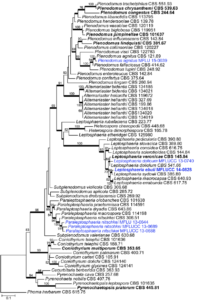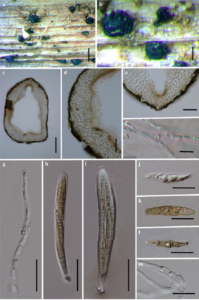Leptosphaeria ebuli Jayasiri, Camporesi&K.D. Hyde.
Index Fungorum number: IF550958, Facesoffungi number:FoF: 00454; Fig. 2
Etymology – In reference to its occurrence on Sambucus ebulus
Holotype – MFLU 14–0820
Saprobic on dead stem of Sambucus ebulus. Sexual morph Ascomata 226 – 396 × 241 – 251 μm (x̄ = 300 × 241 μm,n = 10), solitary or scattered, initially immersed, becoming erumpent to near superficial, globose to subglobose, broadly or narrowly conical, coriaceous, smooth-walled, ostiolate. Ostiole usually broadly papillate, darkened at the base, Peridium 24 – 26 μm (x̄ = 45 μm, n = 20) wide, comprising two types of cells, outer cells of 1 – 2 layers of heavily pigmented cells of textura angularis, inner layer composed of small, light brown to hyaline cells of textura angularis. Hamathecium of septate, long, hyaline, cellular pseudoparaphyses, embedded in gelatinous matrix between and above the asci. Asci 80 – 109 × 8 – 9 μm (x̄ = 100 × 9 μm, n = 20), 8 – spored, bitunicate, fissitunicate, clavate to sub – cylindrical, with a short, broad pedicel, thickened and rounded at apex with a distinct ocular chamber surrounded by a large, distinct, apical ring. Ascospores 23 – 28 × 4 – 5 μm (x̄ = 25 × 5.8 μm, n = 40), biseriate to overlapping tri-seriate, ellipsoidal with broadly rounded ends, hyaline to light brown when immature, becoming brown to chestnut brown when mature, 3 – septate, smooth – walled, lacking a sheath. Asexual morph Undetermined.
Culture characters – Ascospores germinated on MEA at 18 °C within 24 h and germ tubes were produced from both ends of ascospores. Colonies on MEA were growing fast (within one week 2 cm diam. colony), white-gray.
Material examined – ITALY, Province of Monte Fumaiolo (FC), on stems of Sambucus ebulus L. (Adoxaceae), 23 July 2014, E. Camporesi (MFLU 14–0820, holotype); ex-type living cultures, MFLUCC 14–0828; GenBank ITS: KP744446; LSU: KP744488; SSU: KP753954.
Notes – Multi – gene phylogenetic analysis (Fig. 1) indicated that Leptosphaeria ebuli forms a distinct clade sister to Leptosphaeria sydowii clade (BS support 96 %) whichis known as an asexual morph (de Gruyter et al. 2012). The morphological characters of L. ebuli is fit with the generic concept of Leptosphaeria in having superficial ascomata with a shiny papilla, multi-layered peridium comprising cells of textura angularis, cellular pseudoparaphyses and fissitunicate, narrowly cylindrical asci bearing multi septate, yellowish-brown to brown ascospores but differ from the generic type of L.doliolum in the shape of the ascomata (globose to subglobose versus conical), width of the ostiole (narrow versus broad) ostiole pore and the size of the ascospores (25× 5.8μm versus 18×3μm). Hence we introduced Leptosphaeria ebuli in Leptosphaeria as new species based on both molecular data coupled with morphology.

Fig. 1 Phylogram generated from Maximum likelihood (RAxML) analysis based on combined LSU and ITS sequence data of Leptosphaeriaceae. Maximum likelihood bootstrap support values greater than 50 % are indicated above or below the nodes, and branches with Bayesian posterior probabilities greater than 0.95 are given in bold. The ex-types (reference strains) are in bold; the new isolates are in blue. The tree is rooted with Phoma herbarum CBS 615.75

Fig. 2 Leptosphaeria ebuli (holotype). a,b Ascomata c Section through the ascoma d Peridium e Pseudoparaphyses f Immature ascus g, h Mature asci j-l Ascospores. Scale bars: a = 500 μm, b = 100 μm, c = 100 μm, d, f – h = 30 μm, e = 10 μm, i – l = 10 μm.
